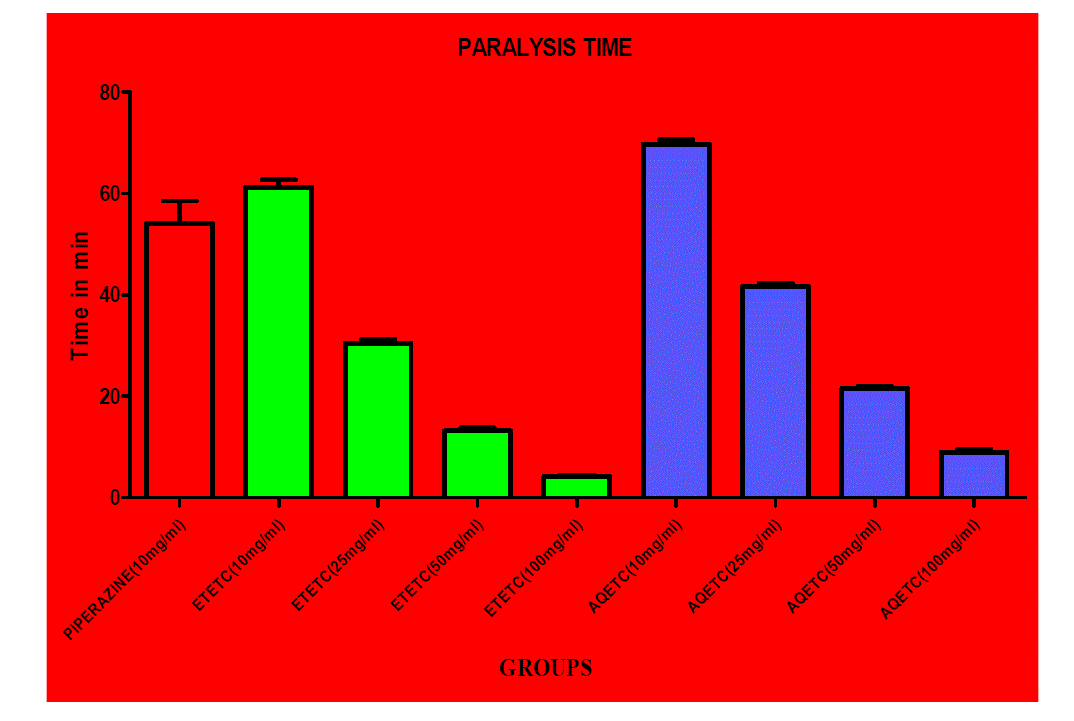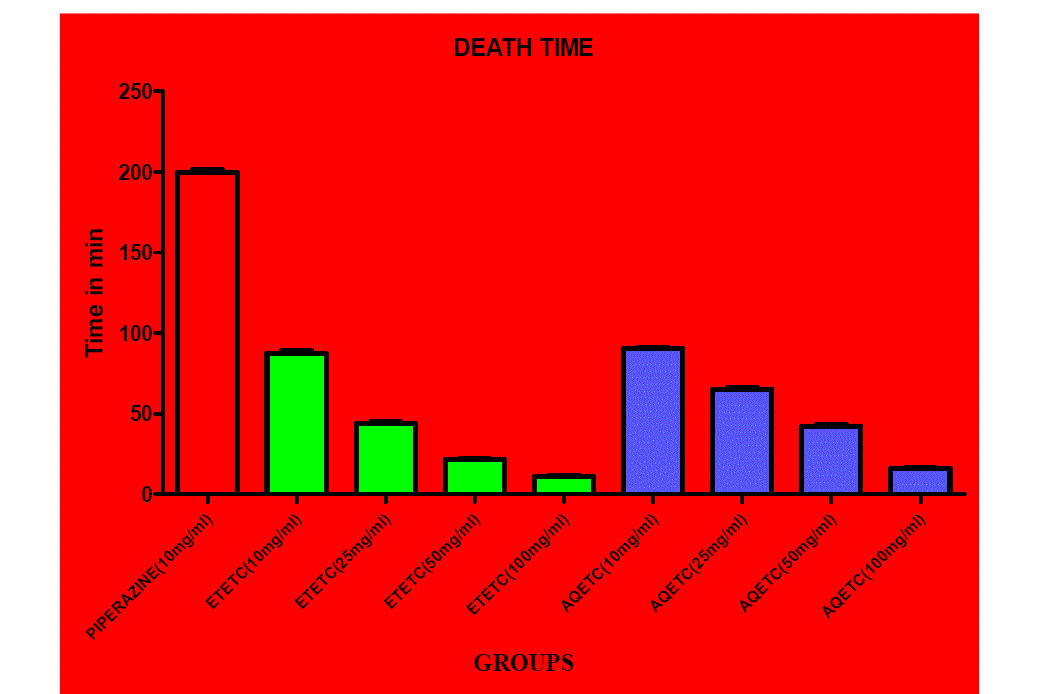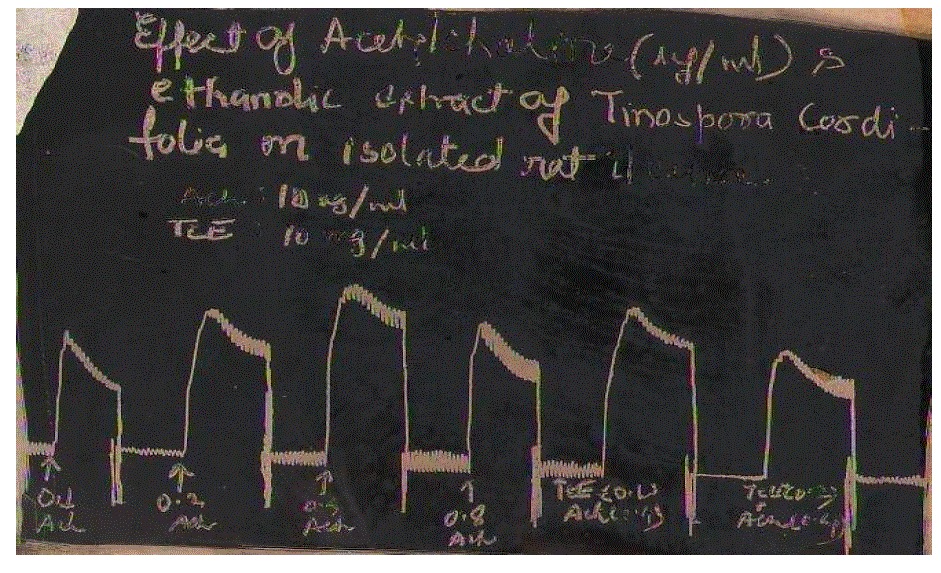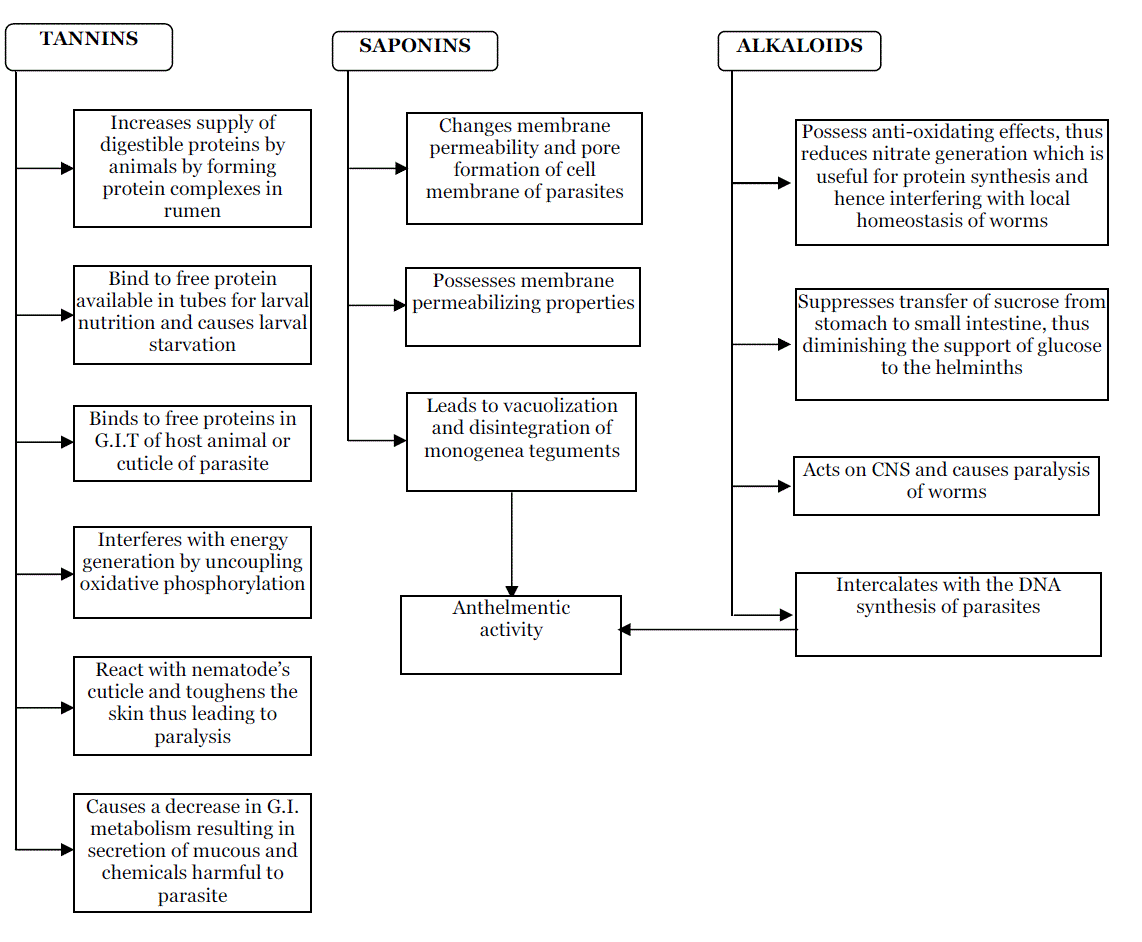Key words
|
| |
| Tinospora cordifolia, Anthelmintic, Eisenia foetida, Piperazine Citrate |
| |
INTRODUCTION
|
| |
| Helminths are parasitic worms. They are the most common infectious agents of humans in developing countries and produces a global burden of disease that exceeds conditions including malaria and tuberculosis. There are two major phyla of helminths. The nematodes (also known as roundworms) include the major intestinal worms (also known as soiltransmitted helminths) and the filarial worms that cause lymphatic filariasis (LF) and onchocerciasis, whereas the platyhelminths (also known as flatworms) include the flukes (also known as trematodes), such as the schistosomes, and the tapeworms (also known as the cestodes), such as the pork tapeworm that causes cysticercosis [1]. The World Health Organization reveals that over two billion people are suffering from parasitic worm infections [2]. It is estimated that by the year 2025, about 57% of the population in developing countries will be influenced [3]. The prevalence of parasitic helminths typically displays a negative binomial distribution within an infected population such that relatively few persons carry heavy parasite burdens. Without treatment, those individuals are most likely to become ill and to perpetuate infection within their community [4]. |
| |
| Anthelmintics are drugs that may act locally to expel worms from the GIT or systemically to eradicate adult helminths or development forms that invade organs and tissues [5]. Helminthes infections are now being recognized as cause of many acute as well as chronic ill health among the various human beings as well as cattle’s. More than half of the population of the world suffers from infection of one or the other and majority of cattle’s suffers from worm infections [6]. In most developing and less developed countries, helminth infections are a major health concern because they predispose humans to other infections such as fungal and bacterial infections [7]. Intestinal infections with worms can more easily treated than those the infections that occurs in other locations in the body, because the worms need to be killed by the drug and the drug need not be absorbed when given by oral route [8]. |
| |
| Most of the existing anthelmintics produces side effects such as abdominal pain, loss of appetite, nausea, Vomiting, headache and diarrhoea [9]. Anthelmintics from the natural sources may play a key role in the treatment of these parasite infections [10]. In ethnomedicine, at least 80% of the world’s population in developing countries uses plant materials as their source of primary health care [11]. Increasing problems of development of resistance in helminths against anthelmintics have led to the proposal of screening medicinal plants for their anthelmintic activity [12]. Because of the increasing anthelmintic resistance and the impact of conventional anthelmintics on the environment, it is important to look for alternative strategies against gastrointestinal nematodes [13]. Suitable targets in helminths include processes such as muscular activity and neuromuscular coordination, sensory processes, feeding and the regulation of coelomic pressure. There are some potential chemotherapeutic targets which include: |
| |
| 1. Energy metabolism |
| |
| 2. Nutrient uptake |
| |
| 3. Nucleic acid metabolism |
| |
| 4. Anabolic pathways [14]. |
| |
| Tinospora cordifolia is a large, glabrous, deciduous climbing shrub belonging to the family Menispermaceae [15]. It has been shown to possess anti-allergic, anti-inflammatory, antioxidant activities [16], immuno-modulatory, hepatoprotective, antipyretic [17], antidiabetic [18], anti-hyperlipidimic properties [19], urinary diseases, syphilis, skin diseases, and bronchitis [20]. Tinospora cordifolia has been known to promote longevity and increase the body’s resistance against various diseases [21]. In Ayurveda, Tinospora cordifolia is used as “rasayana” which in Sanskrit implies circulation of “rasa”- the nutrient. The ancient Indian physician, Charaka described rasayana as antiaging, increasing the life span, promoting intelligence, improving memory and freedom from diseases, indicating immunostimulant effect [22]. Tinospora cordifolia has been traditionally used as an anthelmintic [23]. However, anthelmintic activity of Tinospora cordifolia stem has not so far been scientifically proved, so the present study was carried out to assess the anthelmintic activity of Tinospora cordifolia against Eisenia foetida. |
| |
MATERIALS AND METHODS
|
| |
|
Plant collection and authentication
|
| |
| Tinospora cordifolia (Menispermaceae), stem was collected from the plant growing at Hoshiarpur, Punjab State, India and were authenticated in the Regional Research Institute, Bangalore, India where voucher specimen was deposited. The reference number of specimen was Drug Authentication/SMPU/NADRI/BNG/2010-11/573. |
| |
|
Worms Collection and authentication
|
| |
| Eisenia foetida was collected from the water logged areas of the soil and identified and authenticated at the Ujjwal Ujala Vermiculture Group, Vill. Ibban Kalan, Amritsar and its reference number is UU/1210/AL-34. |
| |
|
Preparation of Extract
|
| |
| Soxhlet extraction is only required where the desired compound has a limited solubility in a solvent, and the impurity is insoluble in that solvent. If the desired compound has a high solubility in a solvent then a simple filtration can be used to separate the compound from the insoluble substance. The advantage of this system is that instead of many portions of warm solvent being passed through the sample, just one batch of solvent is recycled [24]. |
| |
|
Aqueous extract preparation:
|
| |
| The crude aqueous extract (AQETC) of the Tinospora cordifolia stem was prepared according to the standard method. One hundred grams of the powdered plant material was mixed with 500 mL of distilled water in a Soxhlet apparatus for 20-24 h. The filtrate was then concentrated in a rotary evaporator and the extract stored at 4ºC until required. The extract yield (% w/w) from the plant material was recorded as 7.1%. |
| |
|
Ethanolic extract preparation:
|
| |
| The powder stem material of Tinospora cordifolia was placed in a thimble and extracted with 70% ethanol in a Soxhlet apparatus for 20-24 h. Solvents were removed at temperature below 50ºC in an oven. The residue (extract) of respective plant material was stored at 4°C until used. The extract (ETETC) yield (% w/w) from the plant material was recorded as 3.2%. |
| |
| Phytochemical evaluation: Phytochemical examinations were carried out for all the extracts as per the standard methods |
| |
| 1. Detection of alkaloids: Extracts were dissolved individually in dilute Hydrochloric acid and filtered. |
| |
| a) Mayer’s Test: Filtrates were treated with Mayer’s reagent (Potassium Mercuric Iodide). Formation of a yellow coloured precipitate indicates the presence of alkaloids. |
| |
| b) Wagner’s Test: Filtrates were treated with Wagner’s reagent (Iodine in Potassium Iodide). Formation of brown/reddish precipitate indicates the presence of alkaloids. |
| |
| c) Dragendroff’s Test: Filtrates were treated with Dragendroff’s reagent (solution of Potassium Bismuth Iodide). Formation of red precipitate indicates the presence of alkaloids. |
| |
| d) Hager’s Test: Filtrates were treated with Hager’s reagent (saturated picric acid solution). Presence of alkaloids confirmed by the formation of yellow coloured precipitate |
| |
| 2. Detection of carbohydrates: Extracts were dissolved individually in 5 ml distilled water and filtered. The filtrates were used to test for the presence of carbohydrates. |
| |
| a) Molisch’s Test: Filtrates were treated with 2 drops of alcoholic α-naphthol solution in a test tube. Formation of the violet ring at the junction indicates the presence of Carbohydrates. |
| |
| b) Benedict’s Test: Filtrates were treated with Benedict’s reagent and heated gently. Orange red precipitate indicates the presence of reducing sugars. |
| |
| c) Fehling’s Test: Filtrates were hydrolysed with dil. HCl, neutralized with alkali and heated with Fehling’s A & B solutions. Formation of red precipitate indicates the presence of reducing sugars. |
| |
| 3. Detection of glycosides: Extracts were hydrolysed with dil. HCl, and then subjected to test for glycosides. |
| |
| a) Modified Borntrager’s Test: Extracts were treated with Ferric Chloride solution and immersed in boiling water for about 5 minutes. The mixture was cooled and extracted with equal volumes of benzene. The benzene layer was separated and treated with ammonia solution. Formation of rosepink colour in the ammonical layer indicates the presence of anthranol glycosides. |
| |
| 4. Legal’s Test: Extracts were treated with sodium nitropruside in pyridine and sodium hydroxide. Formation of pink to blood red colour indicates the presence of cardiac glycosides. |
| |
|
Detection of saponins
|
| |
| a) Froth Test: Extracts were diluted with distilled water to 20ml and this was shaken in a graduated cylinder for 15 minutes. Formation of 1 cm layer of foam indicates the presence of saponins. |
| |
| b) Foam Test: 0.5 gm of extract was shaken with 2 ml of water. If foam produced persists for ten minutes it indicates the presence of saponins. |
| |
|
Detection of phytosterols
|
| |
| a) Salkowski’s Test: Extracts were treated with chloroform and filtered. The filtrates were treated with few drops of Conc. Sulphuric acid, shaken and allowed to stand. Appearance of golden yellow colour indicates the presence of triterpenes |
| |
| b) Libermann Burchard’s test: Extracts were treated with chloroform and filtered. The filtrates were treated with few drops of acetic anhydride, boiled and cooled. Conc. Sulphuric acid was added. Formation of brown ring at the junction indicates the presence of phytosterols. |
| |
|
Detection of phenols
|
| |
| Ferric Chloride Test: Extracts were treated with 3-4 drops of ferric chloride solution. Formation of bluish black colour indicates the presence of phenols. |
| |
|
Detection of tannins
|
| |
| Gelatin Test: To the extract, 1% gelatin solution containing sodium chloride was added. Formation of white precipitate indicates the presence of tannins. |
| |
|
Detection of flavonoids
|
| |
| a) Alkaline Reagent Test: Extracts were treated with few drops of sodium hydroxide solution. Formation of intense yellow colour, which becomes colourless on addition of dilute acid, indicates the presence of flavonoids. |
| |
| b) Lead acetate Test: Extracts were treated with few drops of lead acetate solution. Formation of yellow colour precipitate indicates the presence of flavonoids. |
| |
|
Detection of proteins and aminoacids
|
| |
| a) Xanthoproteic Test: The extracts were treated with few drops of conc. Nitric acid. Formation of yellow colour indicates the presence of proteins. |
| |
| b) Ninhydrin Test: To the extract, 0.25% w/v ninhydrin reagent was added and boiled for few minutes. Formation of blue colour indicates the presence of amino acid. |
| |
|
Detection of diterpenes
|
| |
| Copper acetate Test: Extracts were dissolved in water and treated with 3-4 drops of copper acetate solution. Formation of emerald green colour indicates the presence of diterpenes [25, 26, 27]. |
| |
|
Anthelmintic Assay
|
| |
| The assay was performed on adult earthworm, Eisenia foetida due to its anatomical and physiological resemblance with the intestinal roundworm parasite of human beings [28, 29]. Because of easy availability, earthworms have been used extensively for the preliminary in vitro evaluation of anthelmintic compounds in vitro [30, 31, 32, 33, 34, 35]. It has been verified that all anthelmintics which are toxic to earthworms are creditable to study as an anthelmintic [2, 40]. 100 ml formulations containing four different concentrations, each of aqueous and ethanolic extract of its various fractions (10, 25, 50 and 100 mg/ml in distilled water) were prepared and six worms (same type) were placed in it. Time for paralysis was noted when no movement of any sort could be observed except when the worms were shaken vigorously. Time for death of worms were recorded after ascertaining that the worms neither moved when shaken vigorously nor when dipped in warm water (50 °C). Piperazine Citrate (10 mg/ml) was used as reference standard. |
| |
|
Bioassay for anticholinergic effect of ETETC:
|
| |
| Because of its more potent effect with respect to the aqueous extract, anticholinergic effect of the ethanolic extract was performed on isolated rat ileum. Rat was anaesthetised and sacrificed. The ileum was isolated and mounted in an organ bath containing the physiological salt solution (Tyrode) kept at 37 ºC. The effect of acetylcholine was firstly seen till the ceiling dose after which the combined effect of ETETC and acetylcholine were seen by chosing a single dose of acetylcholine from the previous response curves which indicated the anticholinergic activity of Tinospora cordifolia. |
| |
|
Statistical analysis
|
| |
| Data were analyzed using one way factorial ANOVA tests followed by Dunnett’s t -tests on each group. P values under 0.01 were considered highly significant (shown as **). |
| |
RESULT
|
| |
| Preliminary phytochemical screening of Tinospora cordifolia stem extract revealed the presence of proteins, saponins, steroids, carbohydrates, alkaloids, tannins, glycosides, flavonoids and phenols (Table 1). The anthelmintic activity of ethanolic extract of Tinospora cordifolia (ETETC) was more potent than aqueous extract of Tinospora cordifolia (AQETC) was comparable with that of standard drugs piperazine citrate. At the concentration of 100 mg/ml both the ethanolic and the aqueous extracts showed very significant activities as compared to the standard drug piperazine citrate (10 mg/ml), the time of paralysis and death being 9 ± 0.57 and 15.83 ± 0.60 in case of aqueous and 4.16 ± 0.30 and 10.83 ± 0.60 in case of ethanolic extracts respectively. The stem extracts of Tinospora cordifolia produced a significant anthelmintic activity in dose dependent manner as shown in (Table 2). |
| |
DISCUSSION
|
| |
| The main advantages of using in vitro assays to screen the anti-parasitic properties of the plants and plant extracts include low costs and rapid turnover which allow the screening of plants at large scale. In addition, these tests measured the effect of anthelmintic activity directly on the processes of hatching, development and motility of parasites without interfering the internal physiological functions of the host [36]. |
| |
| The higher activity of the ethanolic extracts as compared to the aqueous extract can be attributed to the presence of higher amounts of polyphenols as compared to aqueous extracts. It means that they are more efficient in cell walls and seeds degradation which have unpolar character and cause polyphenols to be released from cells. More useful explanation for the decrease in activity of aqueous extract can be ascribed to the enzyme polyphenol oxidase, which degrade polyphenols in water extracts, whereas in methanol and ethanol they are inactive. Moreover, water is a better medium for the occurrence of the micro-organisms as compared to ethanol [37]. The higher concentrations of more bioactive flavonoid compounds were detected with ethanol 70% due to its higher polarity than pure ethanol. By adding water to the pure ethanol up to 30% for preparing ethanol 70% the polarity of solvent was increased [38]. Additionally, ethanol was found easier to penetrate the cellular membrane to extract the intracellular ingredients from the plant material [39]. |
| |
| Earthworms have the ability to move by ciliary movement. The outer layer of the earthworm is a mucilaginous layer and composed of complex polysaccharides. This layer being slimy, enables the earthworm to move freely. Any damage to the mucopolysaccharide membrane will expose the outer layer and this restricts its movement and can cause paralysis. This action may lead to the death of the worm by causing damage to the mucopolysaccharide layer. This causes irritation leading to paralysis [2, 40]. |
| |
| All anthelmintics essentially kill worms by either starving them to death or paralyzing them. As worms have no means of storing energy, they must eat almost continuously to meet their metabolic needs. Any disruption in this process results in energy depletion. Interfering with feeding for 24 hours or less is sufficient to kill most adult parasites. Parasites will also die if they become paralyzed and temporarily lose their ability to maintain their position in the gut [41]. |
| |
| Preliminary phytochemical screening of Tinospora cordifolia extract revealed the presence of proteins, saponins, steroids, carbohydrates, alkaloids, tannins, glycosides, flavonoids and phenols. The possible mechanism of action of tannins may to interfere with energy generation by uncoupling oxidative phosphorylation [42, 43, 44]. Another possible mechanism of action is that they bind to free proteins in the gastrointestinal tract of the host animal or to glycoprotein on the cuticle of the parasite and by this cause death. Several other reports suggested that an increase in the supply of digestible protein does improve the resilience and resistance of sheep to gastrointestinal nematodes. Tannin containing plants increase the supply and absorption of digestible protein by animals. This is achieved by formation of protein complexes in the rumen by tannins, which later dissociate at low pH in the abdomen to release more protein for metabolism in the small intestines of ruminant animals [45, 46]. |
| |
| Alkaloids may act on central nervous system and caused paralysis of the earthworm [47]. |
| |
| The study suggest that the effect would be due to presence of the steroidal alkaloid oligoglycosides which may suppress the transfer of sucrose from the stomach to the small intestine which could diminish the support of glucose to helminthes together with its antioxidant effect which is capable of reducing the nitrate generation (which can be used in the protein synthesis) as well as the possible inflammatory effect induced by the extract in the gastric and intestinal mucosal which could interfere in local homeostasis which is essential for the development of helminthes [48]. |
| |
| The phytochemical screening of the extracts also revealed the presence of saponins. Recent research addressed that the main biologic activity ascribed to saponins was their membrane permeabilizing property. The main actions considered were changes in membrane permeability and pore formation, which is similar with two conventional anthelmintic drugs such as praziquantel and toltrazuril. That is, they would affect the permeability of the cell membrane of the parasites and causes vacuolization and disintegration of monogenea teguments [49]. |
| |
| Coming to the chemistry of nematode surface, it is a collagen rich extracellular matrix (ECM) providing protective cuticle that forms exoskeleton, and is critical for viability, the collagen is a class of proteins that are modified by a range co-translational and post-translational modification prior to assembly into higher order complexes (or) ECMS. The mammalian skin also consists largely of collagen in the form of fibrous bundles. In leather making industry, vegetable tannins are commonly used in the tanning operation of leather processing that imparts stability to collagen of skin matrix through its reactivity and hence make the collagen molecule aggregate into fibres. This results in the loss of flexibility in the collagen matrix and gain of mechanical property with improved resistance to the thermal or microbial/enzymatic attacks. Similar kind of reaction is expected to take place between the nematode cuticle (the earthworm) and the tannins of plants, possibly by linking through hydrogen bonding. This form of reactivity brings toughness in the skin and hence the worms become immobile and non-functional leading to paralysis followed by death [50]. The anthelmintic activities of crude extracts can also be explained in part by their partial lipophilic nature, which renders the cells leaky and thereby results in cell death [51]. |
| |
| Beta-sitosterol which is also present in Tinospora cordifolia [52] is known previously to exert anthelmintic activity but the mechanism of action is still unkown [53]. The pH of the ethanolic extract was found to be 2.48 which might be the reason for its high activity as the lower pH may cause the starvation effects or give rise to the osmotic abnormalities thus leading to the death of the worms [54]. |
| |
| Tinospora cordifolia is also known to contain tetrahydropalmatine [52]. The inhibitory effects of phytochemicals from Tinospora cordifolia on NOS activity, NO efflux concentration may be due to the presence of tetrahydropalmatine, which is reported to inhibit NOS expression and NO production. Being a non polar molecule, the released NO diffuses through cell membranes and its physiological functions are mostly mediated by cGMP. At a molecular level, NO exerts its most relevant physiological action by activating the soluble form of guanylyl cyclase, leading to the accumulation of cGMP, an important messenger mediating the functions of NO inside the cell [55]. The anthelmintic activity of Tinospora cordifolia might be due to the presence of alkaloids which have ability to intercalate with DNA synthesis of parasites [56]. |
| |
| Transcuticular diffusion is a common means of entry into helminth parasites [57] for non-nutrient and non-electrolyte substances in nematodes. It has also been shown that this route is predominant for the uptake of major broad spectrum anthelmintics by different nematode, cestode and trematode parasites. The possible explanation for better anthelmintic activity of ethanolic extract compared to aqueous extract on larvae and adults parasites could be due to easier transcuticular absorption [56]. |
| |
| The anthelmintic effects of tannins may be attributed to its capacity to bind free protein available in the tubes for larval nutrition and thus reduced nutrient availability could have resulted in larval starvation or decrease in gastrointestinal metabolism thus causing larval death. Tannins may also induce physiological changes in the gut of the host resulting in secretion of mucous and chemicals harmful to the parasite [58]. |
| |
| The possible explanation for the better activity of the hydro-alcoholic extract compared to the aqueous extract on adult parasites in the current study could be due to easier transcuticular absorption of the hydroalcoholic extracts into the body of the parasite than the aqueous extracts. In general, hydroalcoholic extracts of plants contain some non-polar organic chemicals with lower polarity than the aqueous extracts, rendering them more lipid soluble than the aqueous extracts and hence better anthelmintic activity. Lipophilic anthelmintics have a greater capability to cross the external surface of the helminths than the hydrophilic compounds [59]. |
| |
| Piperazine citrate by increasing chloride ion conductance of worm muscle membrane produces hyperpolarisation and reduced excitability that leads to muscle to relaxation and flaccid paralysis [60]. The anthelmintic drug piperazine citrate exerts an anticholinergic action at the myoneural junction in the worms. piperazine acts as a myoneural blocking agent in worms, so enabling the paralysed worms to be expelled from the host’s gut by normal peristalsis [61, 62]. The anticholinergic agents such as atropine have been found to enhance the anthelmintic activity of the organophosphorous compounds [63]. The ethanolic extract of Tinospora cordifolia (10 mg/ml) decreased the contractions mediated by acetylcholine in the bioassay using isolated rat ileum (Figure 3) thus showing an anticholinergic action. Thus, the possible anthelmintic action of Tinospora cordifolia may be due to its anticholinergic action. |
| |
CONCLUSION
|
| |
| It can be concluded that active constituents responsible for anthelmintic activity are present in the aqueous and ethanolic extracts of stem of Tinospora cordifolia. Further work will emphasize the isolation and characterization of active principles responsible for anthelmintic activity of stem extracts of Tinospora cordifolia. |
| |
ACKNOWLEDGEMENT
|
| |
| The authors are thankful to Dr. Monica Gulati, Dean, Department of Pharmaceutical Sciences, Lovely Professional University, Phagwara (Punjab) for providing necessary facilities and cooperation during this research work. |
| |
Conflict of Interest
|
| |
| NIL |
| |
Source of Support
|
| |
| NONE |
| |
Tables at a glance
|
 |
 |
| Table 1 |
Table 2 |
|
| |
Figures at a glance
|
 |
 |
 |
 |
| Figure 1 |
Figure 2 |
Figure 3 |
Figure 4 |
|
| |










